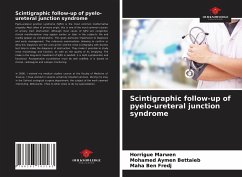Pyelo-ureteral junction syndrome (SJPU) is the most common malformative uropathy. Most often of primary origin, this is one of the most common causes of urinary tract obstruction. Although most cases of SJPU are congenital, clinical manifestations may appear earlier or later in the subject's life and readily appear as complications. This gives particular importance to diagnosis and early management. The reference examinations allowing to confirm or deny this diagnosis are the uroscanner and the renal scintigraphy with diuretic test help to make the diagnosis of obstruction. They make it possible to study renal morphology and function, as well as the quality of its emptying. The stake in the long-term treatment of SJPU is twofold: it is both symptomatic and functional. Postoperative surveillance must be well codified. It is based on clinical, radiological and isotopic monitoring.
Bitte wählen Sie Ihr Anliegen aus.
Rechnungen
Retourenschein anfordern
Bestellstatus
Storno








